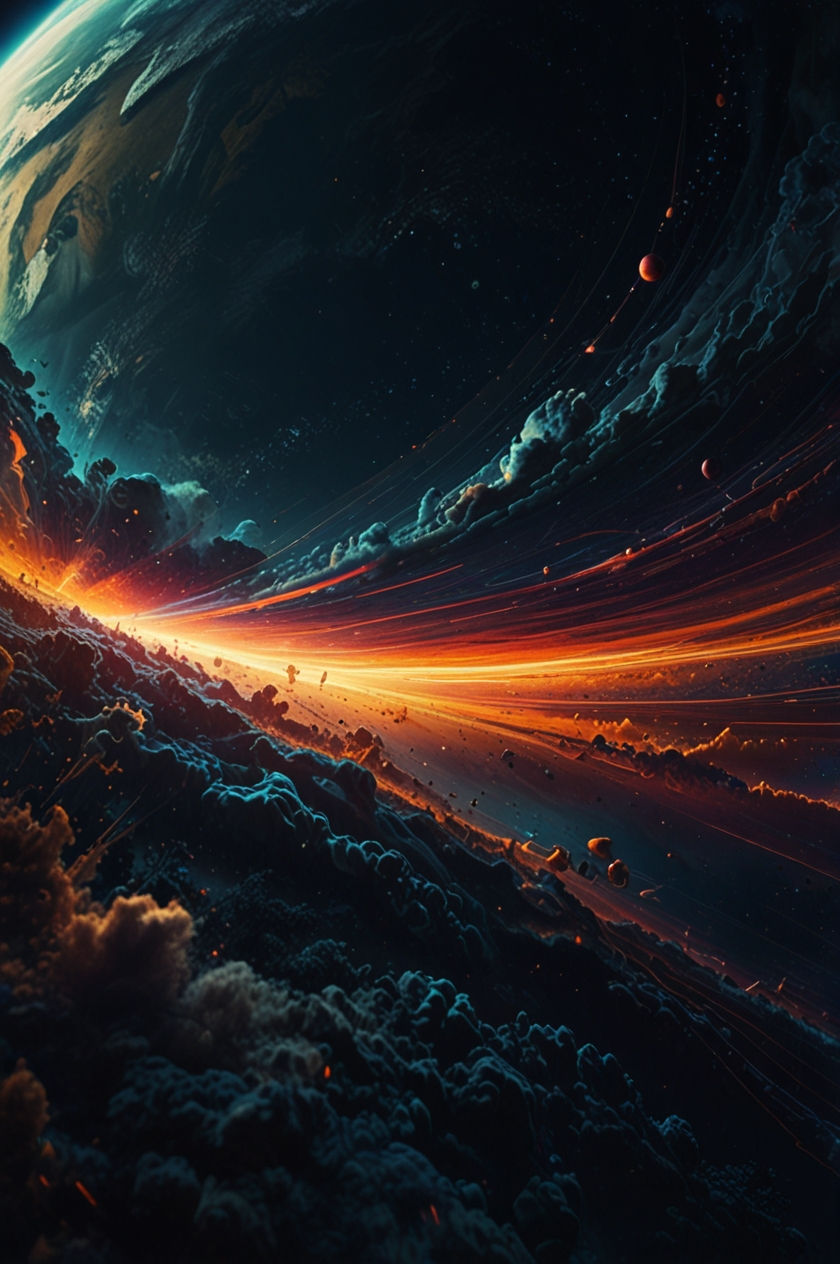Are Solar Flares Sparking Our Inner Chaos?
- AI it News

- Sep 11
- 9 min read
The Unseen Hand of Our Sun.

In the relentless hum of modern life, we often seek explanations for the chaos that swirls around us. Economic downturns, political polarization, social injustices – these are the familiar culprits we point to when society teeters on the brink of unrest. But what if there's a deeper, more primal force at play, one that emanates not from the halls of power or the inequities of our systems, but from the very heart of our solar system? What if the Sun, our life-giver, occasionally whispers a frequency that stirs our collective unconscious, urging us towards irrationality, conflict, and even outright rebellion?
It's a provocative thought, one that might sound like the stuff of science fiction. Yet, an intriguing hypothesis is gaining traction among a fringe of scientists and keen observers: that solar flares, those spectacular eruptions on our Sun's surface, can dramatically alter Earth's natural electromagnetic rhythms, specifically the Schumann Resonance, leading to heightened human irrationality, emotional volatility, and a greater propensity for civil unrest and riots.
Prepare to journey into a realm where astrophysics meets psychology, where the Sun's fiery breath might just be fanning the flames of human discord. This isn't just about understanding the weather; it's about understanding ourselves, and the subtle, profound forces that shape our collective destiny.
The Sun's Fiery Breath: More Than Just Light and Warmth

Our Sun is a magnificent, dynamic star, constantly spewing energy into space. Most of the time, this energy arrives as life-sustaining light and warmth. However, our star is also prone to violent outbursts known as solar flares. These are sudden, intense bursts of radiation – X-rays, gamma rays, and highly energetic particles – that erupt from the Sun’s surface. When these flares are powerful enough, they launch a torrent of charged particles, a phenomenon known as a Coronal Mass Ejection (CME), hurtling through the cosmos at incredible speeds.
These cosmic cannonballs usually take a few days to reach Earth. When they do, they collide with our planet's magnetosphere, the protective bubble of magnetic force that shields us from the harsh realities of space. The interaction is often visible as the breathtaking aurora borealis and australis, but it also causes geomagnetic storms – disturbances in Earth's magnetic field.
We've long known that these storms can have tangible effects: disrupting radio communications, causing power grid fluctuations, and even interfering with satellite operations. But what if their influence extends beyond our technology, subtly yet powerfully infiltrating the very essence of our biological and neurological systems? What if the invisible forces of the cosmos are not merely background noise, but active players in the human drama?

Earth's Heartbeat: The Schumann Resonance
To understand this potential link, we must first introduce Earth's own natural rhythm – the Schumann Resonance.
Imagine our planet as a giant spherical capacitor. The Earth's surface and the ionosphere (a layer of charged particles in the upper atmosphere) act as two conductive plates, separated by the insulating atmosphere. Within this cavity, electromagnetic waves are constantly bouncing around, created primarily by lightning strikes worldwide. These waves create a set of resonant frequencies, the most prominent of which hovers around a remarkably stable 7.83 Hertz (Hz). This fundamental frequency, along with its harmonics (around 14 Hz, 20 Hz, 26 Hz, etc.), is what scientists refer to as the Schumann Resonance.
Often called Earth's "heartbeat" or "brainwave," the Schumann Resonance is a fundamental part of our planet's electromagnetic environment. It's a natural pulse, a steady thrum that has been present for millennia, long before the advent of human civilization. For most of history, it was assumed to be a constant, benign background presence, largely ignored in the study of human behavior.
However, recent observations and studies suggest that the Schumann Resonance is not entirely static. It can fluctuate, and critically, it can be significantly impacted by solar flares and the resulting geomagnetic storms. When these energetic particles from the Sun slam into our magnetosphere, they can excite and amplify the Schumann Resonance frequencies. The 7.83 Hz 'base' can spike dramatically in intensity, and the higher harmonic frequencies can also become more pronounced and erratic. This is where the plot thickens, leading us to consider the profound implications for all life on Earth, especially for us, complex beings whose very existence is steeped in electrical and chemical processes.
The Human Receiver: Our Electromagnetic Nature

So, we have solar flares impacting Earth's Schumann Resonance. But how does an alteration in Earth's electromagnetic field translate into human behavior? The answer lies in our own intricate, electromagnetic nature. The human brain is an exquisitely complex electrical organ, constantly generating brainwaves – rhythmic patterns of electrical activity that correlate with different states of consciousness.
Consider these brainwave states:
Delta waves (0.5-4 Hz): Deep sleep, unconsciousness.
Theta waves (4-8 Hz): Drowsiness, meditation, creativity, emotional processing.
Alpha waves (8-12 Hz): Relaxed awareness, calm, readiness. The 7.83 Hz Schumann Resonance falls right at the lower end of this crucial Alpha-Theta boundary.
Beta waves (12-30 Hz): Alertness, concentration, active thinking, problem-solving, but also anxiety.
Gamma waves (30-100+ Hz): High-level processing, perception, consciousness.
Notice anything striking? The primary Schumann Resonance frequency of 7.83 Hz sits precisely at the boundary between our Alpha and Theta brainwave states – states associated with relaxation, intuition, emotional integration, and a calm, receptive mind. Multiple studies have explored the potential for external electromagnetic fields, even subtle ones, to influence human brainwave patterns and, consequently, our mood, cognition, and overall well-being.
As Nikola Tesla famously mused, and which holds profound relevance here: "The day science begins to study non-physical phenomena, it will make more progress in one decade than in all previous centuries of its existence." Our electromagnetic environment, though unseen, is undeniably a non-physical phenomenon with potentially immense physical and psychological implications. If our brains are finely tuned instruments, then the Schumann Resonance could be a powerful, ambient signal that our bodies and minds are constantly processing, often without our conscious awareness. When this signal is amplified or disrupted by solar activity, it stands to reason that our internal rhythms could be thrown into disarray.
Imagine a finely tuned musical instrument suddenly subjected to a powerful, erratic vibration. Its melody would distort, its harmony would crack. Might the human brain, that most intricate of instruments, react similarly when Earth's fundamental hum begins to throb with unusual intensity?
From Resonances to Riots: The Unsettling Hypothesis

This brings us to the core, unsettling hypothesis: when solar flares cause the Schumann Resonance to surge in intensity, it can profoundly affect human consciousness and behavior, creating a fertile ground for irrationality, heightened aggression, and ultimately, civil unrest.
Here's how this subtle cosmic influence might manifest:
Disruption of Brainwave Patterns: An amplified Schumann Resonance, particularly in the Alpha-Theta range, could potentially overstimulate or disrupt the brain's natural electrical rhythms. This isn't about direct mind control, but rather a subtle energetic 'push' that nudges our brains out of their optimal, balanced states.
Increased Irritability and Anxiety: If our brains are struggling to maintain their normal rhythm, one might experience a pervasive sense of unease, heightened anxiety, or irritability without a clear external cause. Emotions might become more volatile, reactions disproportionate to stimuli.
Impaired Judgment and Decision-Making: The subtle stress on our neurological systems could lead to a reduction in cognitive clarity, making rational thought more difficult. People might become more impulsive, less capable of critical analysis, and more susceptible to emotional appeals or groupthink.

Collective Agitation and Susceptibility to Suggestion: When a significant portion of a population is simultaneously experiencing these subtle internal disruptions, a collective state of agitation can emerge. In such a state, individuals might lose their sense of personal identity and responsibility, becoming more easily swayed by charismatic figures or radical ideas. This is where the sparks of individual frustration can rapidly ignite into the conflagration of collective action.
Gustave Le Bon, in his seminal work The Crowd: A Study of the Popular Mind, eerily captured this phenomenon long before the concept of Schumann Resonance was widely understood: "Man, as a member of a crowd, is a grain of sand amid other grains of sand, which the wind whirls around at will." If solar flares are indeed the "wind" in this analogy, unconsciously agitating the "grains of sand," then the implications for social stability are profound.
It’s not that solar flares cause specific protests or riots. Rather, they might act as a powerful, invisible accelerant. In societies already simmering with economic inequality, political grievances, or social tension, a surge in the Schumann Resonance could be the unseen catalyst that pushes individuals from simmering frustration to explosive action. It might be the subtle, primal nudge that transforms latent anger into overt aggression, quiet discontent into loud rebellion. The rational mind gives way to the primal, reactive self, making individuals more prone to follow the collective current, no matter how illogical or destructive.
Historical Whispers and Future Revelations
Admittedly, directly proving this link through the lens of traditional science is incredibly challenging. How do you isolate the effect of an electromagnetic frequency from the myriad socio-economic, political, and cultural factors that drive human behavior? It requires a different perspective, a willingness to look for correlations and patterns that might otherwise be dismissed as mere coincidence.
However, some researchers have begun to explore correlations between periods of heightened geomagnetic activity (often driven by solar flares) and historical spikes in human conflict, crime rates, and even psychiatric hospital admissions. These studies are nascent and often met with skepticism, but they highlight an important point: we may be far more interconnected with our cosmic environment than we currently comprehend.
As Carl Jung observed, in a quote that speaks to the deeper, less conscious aspects of human experience: "One does not become enlightened by imagining figures of light, but by making the darkness conscious." The "darkness" here isn't evil, but rather the unconscious, the unseen forces that shape us. Understanding the nuanced interplay between solar activity, Earth's resonance, and our own inner states means making conscious these subtle, yet potentially powerful, influences.
The beauty of science, and indeed of human curiosity, lies in its perpetual quest for knowledge, its willingness to challenge assumptions. As Albert Einstein so eloquently stated, "The most beautiful thing we can experience is the mysterious. It is the source of all true art and science." The mysterious connection between solar flares, Schumann Resonance, and human irrationality is precisely this – a compelling mystery inviting deeper exploration.
Navigating the Cosmic Storm: What Can We Do?

If this hypothesis holds even a grain of truth, what are the implications for us, as individuals and as a society?
Awareness is Key: Simply being aware of the potential for cosmic influences can be empowering. Monitoring space weather forecasts (which predict solar flares and geomagnetic storms) might become as important as checking the terrestrial weather. Understanding that a sudden surge in irritability or collective unease might have an external, non-personal cause can help us contextualize our reactions.
Cultivating Inner Resilience: In times of potential cosmic agitation, doubling down on practices that promote emotional regulation, critical thinking, and inner peace becomes paramount. Mindfulness, meditation, spending time in nature, and fostering strong community bonds can act as buffers against external electromagnetic disruptions.
Grounding practices, designed to connect us with Earth's stable frequencies, might prove especially beneficial.
Resisting the Herd Mentality: When collective agitation rises, the temptation to blindly follow the crowd, to succumb to fear or anger, is immense. This hypothesis suggests an added, subtle pressure towards such behavior. Consciously stepping back, questioning narratives, and prioritizing rational thought over emotional reactivity becomes a vital defense against collective irrationality.
Embracing Further Research: We must encourage and support open-minded scientific inquiry into these connections. The tools and methodologies for studying these subtle interactions are constantly evolving. A truly holistic understanding of human behavior demands that we look beyond purely Earth-bound explanations.
This perspective isn’t about fear-mongering; it's about expanding our understanding of ourselves and our place in the universe. It invites us to consider that we are not isolated beings, but intricately woven into the cosmic tapestry, susceptible to its every ripple and surge.
The Great Unseen Influence

The next time you witness civil unrest, a sudden surge in irrational behavior, or an inexplicable wave of collective anger sweeping through a population, pause for a moment. Consider the familiar explanations, yes, but also open your mind to an extraordinary possibility. Could the Sun, our magnificent star, have recently stirred? Could its fiery breath have amplified Earth's subtle heartbeat, sending a resonant signal that momentarily overrides our rational minds, pushing us towards the very edge of chaos?
The idea that solar flares, through their influence on the Schumann Resonance, can increase human irrationality and the propensity for riots and civil unrest, is undeniably profound. It challenges our anthropocentric view of the world and beckons us to consider the vast, unseen forces that continually shape our existence. We are, after all, creatures of the cosmos, dancing to a rhythm far older and more powerful than any drum we've ever beaten. To understand this rhythm, and its occasional chaotic disruptions, is to take a vital step towards truly understanding ourselves, and perhaps, towards navigating the turbulent waters of our collective future with greater wisdom and resilience. There are indeed, as Shakespeare observed, "more things in heaven and earth… than are dreamt of in your philosophy," and some of them may directly influence the very fabric of our societies.




Comments